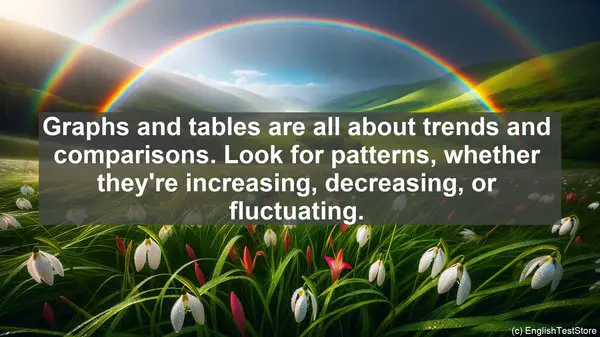Introduction
Welcome to our IELTS Reading series. In today’s lesson, we’ll be diving into the world of graphs and tables. These visual representations are often used to convey information in the Reading section. However, many students find them challenging. But worry not! By the end of this video, you’ll have a solid understanding of the top 10 techniques to tackle them with confidence. Let’s get started!
1. Understand the Axes
The axes of a graph provide crucial information. The horizontal axis, also known as the x-axis, typically represents time or categories. The vertical axis, or y-axis, represents the quantity being measured. Understanding these axes helps you grasp the overall trend and make accurate interpretations.
2. Identify Key Features
Before delving into the details, take a moment to identify the key features of the graph or table. These could be peaks, troughs, significant changes, or patterns. By doing so, you’ll have a roadmap of what to focus on while reading the accompanying questions.

3. Scan the Title and Labels
The title and labels provide valuable context. They often contain keywords that hint at the main theme or purpose of the graph. Paying attention to these can save you time and give you a head start in understanding the data.
4. Skim the Units
Units of measurement are crucial in interpreting data accurately. Skim through the units mentioned in the graph or table. This will help you understand the scale and magnitude of the values being presented.
5. Look for Trends and Comparisons
Graphs and tables are all about trends and comparisons. Look for patterns, whether they’re increasing, decreasing, or fluctuating. Additionally, compare different elements within the graph or table. This will give you a deeper understanding of the relationships.
6. Pay Attention to Headings and Subheadings
If the graph or table is accompanied by headings and subheadings, they’re there for a reason. These headings often summarize the main points or sections. By reading them, you’ll have a clear structure in mind, making it easier to navigate the information.
7. Use Highlighting
When faced with a complex graph or table, it’s helpful to use highlighting. This can be done with a pen and paper or digitally. By highlighting key points, you create visual cues that aid in comprehension and make it easier to refer back to specific details.

8. Practice Estimation
In some cases, you may not need to read every single value on the graph or table. Developing the skill of estimation can save you time. By quickly assessing the approximate values, you can eliminate irrelevant options and focus on the ones that are closest.
9. Read the Captions
Captions, if provided, offer additional information or insights. They may explain abbreviations, provide context, or highlight key findings. Don’t overlook these as they can enhance your understanding of the data.
10. Practice, Practice, Practice
Like any skill, analyzing graphs and tables requires practice. The more exposure you have to different types of visual data, the more comfortable you’ll become. Make it a habit to regularly attempt graph and table-based questions to sharpen your skills.
